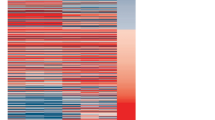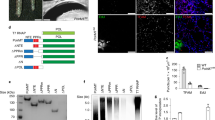Abstract
Poly(ADP-ribose) polymerase (PARP) is conserved in eukaryotes. To analyze the function of PARP, we isolated and characterized the gene for PARP in Drosophila melanogaster. The PARP gene consisted of six translatable exons and spanned more than 50 kb. The DNA binding domain is encoded by exons 1-4. Although the consensus cleavage site of CED-3 like protease during apoptosis is conserved from human to Xenopus laevis PARPs, it is neither conserved in the corresponding region of Drosophila nor Sarcophaga peregrina. There are two cDNAs species in Drosophila. One cDNA could encode the full length PARP protein (PARP I), while the other is a truncated cDNA which could encode a partial-length PARP protein (PARP II), which lacks the automodification domain and is possibly produced by alternative splicing. The expression of these two forms of PARP in E. coli demonstrated that while PARP II has the catalytic NAD-binding domain and DNA-binding domain it is enzymatically inactive. On the other hand PARP I is active. A deletion mutant of PARP gene could grow to the end of embryogenesis but did not grow to the adult fly. These results suggest that the PARP gene plays an important function during the development of Drosophila.
Similar content being viewed by others
References
Miwa M, Sugimura T: ADP ribosylation and carcinogenesis. In: J. Moss, M. Vaughan (eds). ADP Ribosylating Toxins and G Proteins: Insights into Signal Transduction. American Society for Microbiology, Washington, D.C., 1990, pp 543–560
Lautier D, Lagueux J, Thibodeau J, Menard L, Poirier GG: Molecular and biochemical features of poly(ADP-ribose) metabolism. Mol Cell Biochem 122: 171–193, 1993
de Murcia G, de Murcia JM: Poly(ADP-ribose) polymerase: A molecular nick-sensor. TIBS 19: 172–176, 1994
Sugimura T, Miwa M: Poly(ADP-ribose): Historical perspective. Mol Cell Biochem 138: 5–12, 1994
Kameshita I, Matsuda M, Nishikimi M, Ushiro H, Shizuta Y: Reconstitution and poly(ADP-ribosyl)ation of proteolytically fragmented poly(ADP-ribose) sythetase. J Biol Chem 261: 3863–3868, 1986
Uchida K, Miwa M. Poly(ADP-ribose) polymerase: Structural conservation among different classes of animals and its implications. Mol Cell Biochem 138: 25–32, 1994
Lazebnik YA, Kaufmann SH, Desnoyers S, Poirier GG, Earnshaw WC: Cleavage of poly(ADP-ribose) polymerase by a proteinase with properties like ICE. Nature 371: 346–347, 1994
Tewari M, Quan LT, O'Rourke K, Desnoyers S, Zeng Z, Beidler DR, Poirier GG, Salvesen GS, Dixit VM: Yama/CPP32beta, a mammalian homolog of CED-3, is a CrmA-inhibitable protease that cleaves the death substrate poly(ADP-ribose) polymerase. Cell 81: 801–809, 1995
Nicholson DW, Ali A, Thornberry NA, Vaillancourt JP, Ding CK, Gallant M, Gareau Y, Griffin PR, Labelle M, Lazebnik YA, Munday NA, Raju SM, Smulson ME, Yamin TT, Yu VL, Miller DK: Identification and inhibition of the ICE/CED-3 protease necessary for mammalian apoptosis. Nature 376: 37–43, 1995
Molinete M, Vermeulen W, Buerkle A, Menissier-de Murcia J, Kuepper JH, Hoeijmakers JHJ, de Murcia G: Overproduction of the poly(ADPribose) polymerase DNA-binding domain blocks alkylation-induced DNA repair synthesis in mammalian cells. EMBO J 12: 2109–2117, 1993
Song Z, McCall K, Steller H. DCP-1, a Drosophila cell death protease essential for development. Science 275: 536–540, 1997
Miwa M, Hanai S, Masuda H, Koyama Y, Hayashi T, Yoshida Y, Poltronieri P, Maeshima. K, Kobayashi S, Okada M, Uchida K: Analysis of the biological function of poly(ADP-ribosyl)ation in Drosophila melanogaster. Biochimie 77: 466–471, 1995
Wang Z-Q, Auer B, Stingl L, Berghammer H, Haidacher D, Schweiger M, Wagner EF: Mice lacking ADPRT and poly(ADP-ribosyl)ation develop normally but are susceptible to skin disease. Genes Dev 9: 509–520, 1995
de Murcia J, Niedergang C, Trucco C, Ricoul M, Dutrillaux B, Mark M, Oliver W, Masson M, Dierich A, LeMeur M, Walztinger C, Chambon P, de Murcia G: Requirement of poly(ADP-ribose) polymerase in recovery from DNA damage in mice and in cells. Proc Natl Acad Sci USA 94: 7303–7307, 1997
Author information
Authors and Affiliations
Rights and permissions
About this article
Cite this article
Miwa, M., Hanai, S., Poltronieri, P. et al. Functional analysis of poly(ADP-ribose) polymerase in Drosophila melanogaster. Mol Cell Biochem 193, 103–108 (1999). https://doi.org/10.1023/A:1006920429095
Issue Date:
DOI: https://doi.org/10.1023/A:1006920429095




